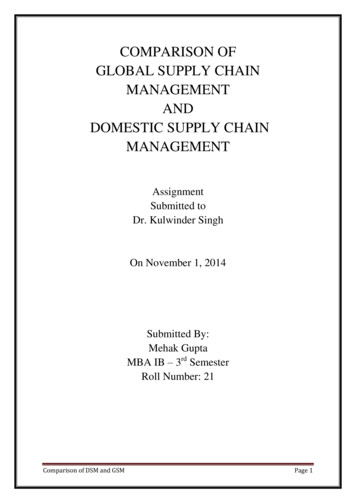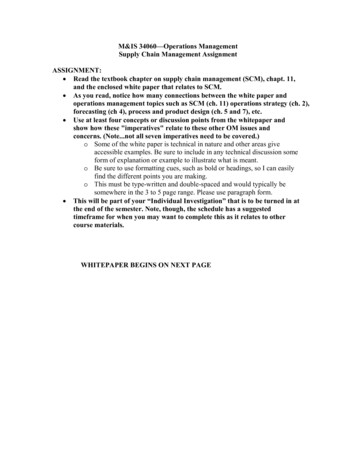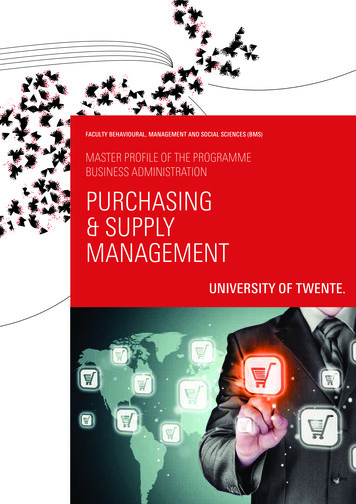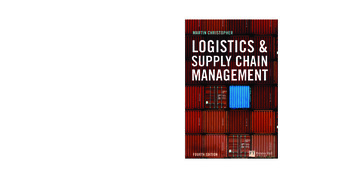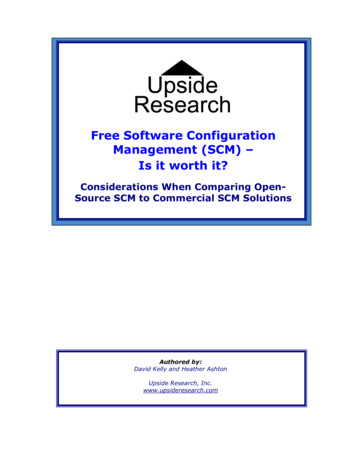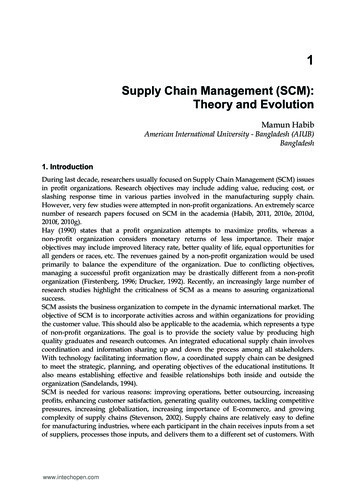
Transcription
1Supply Chain Management (SCM):Theory and EvolutionMamun HabibAmerican International University - Bangladesh (AIUB)Bangladesh1. IntroductionDuring last decade, researchers usually focused on Supply Chain Management (SCM) issuesin profit organizations. Research objectives may include adding value, reducing cost, orslashing response time in various parties involved in the manufacturing supply chain.However, very few studies were attempted in non-profit organizations. An extremely scarcenumber of research papers focused on SCM in the academia (Habib, 2011, 2010e, 2010d,2010f, 2010g).Hay (1990) states that a profit organization attempts to maximize profits, whereas anon-profit organization considers monetary returns of less importance. Their majorobjectives may include improved literacy rate, better quality of life, equal opportunities forall genders or races, etc. The revenues gained by a non-profit organization would be usedprimarily to balance the expenditure of the organization. Due to conflicting objectives,managing a successful profit organization may be drastically different from a non-profitorganization (Firstenberg, 1996; Drucker, 1992). Recently, an increasingly large number ofresearch studies highlight the criticalness of SCM as a means to assuring organizationalsuccess.SCM assists the business organization to compete in the dynamic international market. Theobjective of SCM is to incorporate activities across and within organizations for providingthe customer value. This should also be applicable to the academia, which represents a typeof non-profit organizations. The goal is to provide the society value by producing highquality graduates and research outcomes. An integrated educational supply chain involvescoordination and information sharing up and down the process among all stakeholders.With technology facilitating information flow, a coordinated supply chain can be designedto meet the strategic, planning, and operating objectives of the educational institutions. Italso means establishing effective and feasible relationships both inside and outside theorganization (Sandelands, 1994).SCM is needed for various reasons: improving operations, better outsourcing, increasingprofits, enhancing customer satisfaction, generating quality outcomes, tackling competitivepressures, increasing globalization, increasing importance of E-commerce, and growingcomplexity of supply chains (Stevenson, 2002). Supply chains are relatively easy to definefor manufacturing industries, where each participant in the chain receives inputs from a setof suppliers, processes those inputs, and delivers them to a different set of customers. Withwww.intechopen.com
4Supply Chain Management - Applications and Simulationseducational institutions, one of the primary suppliers of process inputs is customersthemselves, who provide their bodies, minds, belongings, or knowledge as inputs to theservice processes (Habib and Jungthirapanich, 2009b, 2009c, 2010a, 2010c, 2010h, 2010i).This chapter reveals the following objectives: Analysis the overview of SCM through different citations. Review extensive literature reviews regarding SCM based on secondary data. Define the SCM and the evolution of SCM. Analysis the trends of SCM and its future perspectives.2. Literature reviewThe term, “supply chain management,” has risen to eminence over the last ten years. About13.55% of the concurrent session titles contained the words “supply chain” at the 1995Annual Conference of the Council of Logistics Management. The number of sessionscontaining the term rose to 22.4% at the 1997 conference, just two years later. The term iscommonly used to illustrate executive responsibilities in corporations (La Londe 1997). SCMhas become such a “hot topic” that it is difficult to pick up a periodical on manufacturing,distribution, marketing, customer management, or transportation without seeing any articleabout SCM or SCM-related topics (Ross, 1998).Some authors defined SCM in operational terms involving the flow of materials andproducts, some viewed it as a management philosophy, and some viewed it in terms of amanagement process (Tyndall et al., 1998), some viewed it as integrated system. Authorshave even conceptualized SCM differently within the same article: as a managementphilosophy on the one hand, and as a form of integrated system between vertical integrationand separate identities on the other hand (Cooper and Ellram, 1993).According to Christopher (1994), a supply chain is “a network of organizations that areinvolved, through upstream and downstream linkages, in the different processes andactivities that produce value in the form of products and services in the hands of theultimate customer.” An example of a basic supply chain is shown in Figure low of goodsFlow of information and fundsFig. 1. The basic supply chain (Chopra and Meindl, 2001)The supply chain includes suppliers, manufacturers, distributors, retailers, and customers.The customers are the main focus of the chain, since the primary purpose of the existence ofany supply chain is to satisfy customer needs, in the process generating profit for itself(Chopra and Meindl, 2001). SCM was initially related to the inventory management within asupply chain. This concept was later broadened to include management of all functionswww.intechopen.com
Supply Chain Management (SCM): Theory and Evolution5within a supply chain. According to Chopra and Meindl (2001), “SCM engages themanagement of flows between and among stages in a supply chain to minimize total cost”.This definition implies that SCM involves management of flows of products, information,and finance upstream and downstream in the supply chain.In the course of time, the most considerable benefits to businesses with advanced SCMcapabilities will be radically improved customer responsiveness, developed customerservice and satisfaction, increased flexibility for changing market conditions, improvedcustomer retention and more effective marketing (Horvath, 2001).SCM is a concept, “whose primary objective is to integrate and manage the sourcing, flow,and control of materials using a total systems perspective across multiple functions andmultiple tiers of suppliers” (Monczka, Trent and Handfield, 1994). Stevens (1989) stated theobjective of SCM was to synchronize the customers’ requirements with materials flow tostrike a balance among conflicting goals of maximum customer service, minimum inventorymanagement, and low unit costs.The supply chain is viewed as a single process. Responsibility for the different divisions inthe chain is not fragmented and transferred to functional areas such as manufacturing,purchasing, distribution, and sales. SCM calls for, and in the end depends on, strategicdecision-making. “Supply” is a shared objective of practically every function in the chainand is of particular strategic importance because of its impact on overall costs, profits andmarket share. SCM calls for a different point of view on inventories that are utilized as abalancing mechanism of last, not first, resort. A latest approach to systems is required integration rather than interfacing (Houlihan, 1988).SCM is delivering major economic benefits to businesses as diverse as manufacturing, retail,and service organizations, etc. (Horvath, 2001). The scope of SCM was further expanded toinclude re-cycling (Baatz, 1995). SCM deals with the total flow of materials from suppliersthrough end users (Jones and Riley, 1985). It highlights “total” integration of all stakeholderswithin the supply chain, a realistic approach is to consider only strategic suppliers andcustomers since most supply chains are too complex to attain full integration of all thesupply chain entities (Tan et al., 1998).Supply chain strategy includes “two or more firms in a supply chain entering into a longterm agreement; the development of mutual trust and commitment to the relationship; theintegration of logistics events involving the sharing of demand and supply data; thepotential for a change in the locus of control of the logistics process” (La Londe and Masters,1994). Manufacturers are able to develop alternative conceptual solutions, select the bestcomponents and technologies, and assist in design assessment by involving suppliers earlyin the design stage, (Burt and Soukup, 1985).SCM incorporates logistics into the strategic decisions of the business (Carter and Ferrin,1995). Eventually, the philosophy developed and combined into a common body ofknowledge that encompassed all the value-adding activities of the manufacturers andlogistics providers (Tan, 2001). Many SCM strategic models have been investigated to linkits vital role in overall strategic corporate planning (Frohlich et al., 1997; Watts et al., 1992).Experts agree that a formal supply chain strategy will be critical to both manufacturing andservice industries (Kathawala, 2003).Such ambiguity suggests a need to examine the phenomena of SCM more closely to defineclearly the term and concept, to identify those factors that contribute to effective SCM, andwww.intechopen.com
6Supply Chain Management - Applications and Simulationsto suggest how the adoption of an SCM approach can affect corporate strategies, plans,operations and performance.Proper performance measures and metrics including activity-based costing andmanagement may be helpful in identifying non-value-adding activities across a supplychain. Total Quality Management (TQM) methods can be utilized to eradicate theseinefficiencies, thereby improving the overall effectiveness of a supply chain. Customerdemands and supply chain relationships are the key in selecting the most appropriatemethod of target costing for supply chains. Activity-based, process-based, value-based andcost management approaches may be fit for TQM in SCM (Lockamy and Smith, 2000).2.1 Definitions of SCMAmerican Production and Inventory Control Society (APICS, 1990) define the supply chainas the processes from the initial raw materials to final consumption of the finished productslinking across supplier-user industries. The supply chain constitutes all functions withinand outside an industry, which enable the value chain to make products and provideservices to customers (Inman, 1992). Some researchers suggested a clearer SCM definition byadding the information system necessary to monitor all of the activities (Lee, 2002; Morgan,1995; Talluri, 2002).Recently, the Council of SCM Professionals (CSCMP), which is the premier organization ofsupply chain practitioners, researchers, and academicians, has defined SCM as: “SCMencompasses the planning and management of all activities involved in sourcing andprocurement, conversion, and all Logistics Management activities. Importantly, it alsoincludes coordination and collaboration with channel partners, which can be suppliers,intermediaries, third-party service providers, and customers. In essence, SCM integratessupply and demand management within and across companies” (Ballou, 2007).Scott and Westbrook (1991) described SCM as the chain linking each element of themanufacturing and supply process from raw materials to the end user. This managementphilosophy focused on how firms utilized their suppliers’ processes, technology,information, and capability to enhance competitive advantage (Farley, 1997), and thecoordination of the manufacturing, materials, logistics, distribution and transportationfunctions within an organization (Lee and Billington, 1992). SCM is an integrativephilosophy to manage the total flow of a distribution channel from supplier to the ultimateuser (Cooper et al., 1997).Supply chain is defined as all the activities involved in delivering a product from rawmaterials to the customer including sourcing raw materials and parts, manufacturing andassembly, warehousing and inventory tracking, order entry and order management,distribution across all channels, delivery to the customer, and the information systemsnecessary to monitor all of these activities. SCM coordinates and integrates all of theseactivities into a seamless process. It links all of the stakeholders in the chain includingparties within an organization and the external partners including suppliers, carriers, thirdparty companies, and information systems providers (Lummus, 1999).SCM is defined as the systemic, strategic coordination of the traditional business functionsand the tactics across these business functions within a particular organization and acrossbusinesses within the supply chain, for improving the long-term performance of theindividual organization and the supply chain as a whole (Mentzer and et al., 2001).www.intechopen.com
Supply Chain Management (SCM): Theory and Evolution7Most of the recent SCM literature focused on the purchasing function, stating that it was abasic strategic business process, rather than a specialized supporting function (Wisner andTan, 2000). It was a management philosophy that extended traditional internal activities byadopting an inter-enterprise scope, allowing trading partners together with the commongoal of optimization and efficiency (Harwick, 1997).The customized definition for the service industry is as follows: The SCM for the serviceindustry is the ability of the company/firm to get closer to the customer by improving itssupply chain channels. The services supply chain will include responsiveness, effectiveness,efficiency, and controlling (Kathawala, 2003). One of the primary suppliers of process inputsis customers themselves in service organizations. This concept of customers being suppliersis recognized as ‘customer-supplier duality.’ The duality implies that service supply chainsare bi-directional (Sampson, 2000). The concept may be applicable to the academia as well.(Habib, 2010e, 2010g).Integrated SCM is about going from the external customer and then managing all theprocesses that are needed to provide the customer with value in a horizontal way (Monczkaand Morgan, 1997). Generally, SCM comprises integrated functions from raw materials tofinal products. It also covers integrated management of every organization throughout thewhole chain (Horvath, 2001; Talluri, 2002). An analysis of SCM for manufacturing illustratesthe integrated processes required for managing goods from the initial source of supply topoint of consumption. It also includes a wide range of activities that material and servicesuppliers, manufacturers, wholesalers, and retailers have performed for years. Each supplychain participants manage to enhance performance of their own enterprises. Very littleconcentration is given to the benefits of managing the total supply chain process on anintegrated basis (Closs, 1995).SCM, as applied to manufacturing, has been defined differently. These varieties ofdefinitions often carry through to the extent that the key people in the same organization arenot speaking about the same things, when they discuss the concept of SCM (Monczka andMorgan, 1997).First, there are definitions characterized by the simplest concepts of SCM, one is “the abilityto get closer to the customer” (Weil, 1998). Another is that the supply chain is the flow ofinformation and material from suppliers to customers (Crom, 1996). A company’s supplychain, either internal or external, is a resource to be exploited for better market position andenhanced competitive advantage. Strategic use of this resource requires that companies dothe following (Monczka and Morgan, 1997):1. Gain a closer understanding of their customer’ and future customers’ needs, bothnationally and internationally;2. Understand their suppliers’ core competencies in meeting customer needs;3. Determine where redundancies and inefficiencies lie within the supply chain in relationto current and future competitive needs;4. Develop relationships and alliances with suppliers who have key competencies thatstrengthen, supplement, and enhance internal core competencies nationally andinternationally.SCM, from the viewpoint of a manufacturing sector, may be defined as “taking control of allgoods within the supply chain, all materials, no matter how to handle or manage(Sandelands, 1994).” In particular, SCM is the process of effectively managing the flow ofwww.intechopen.com
8Supply Chain Management - Applications and Simulationsmaterials and finished goods from retailers to customers using the manufacturing facilitiesand warehouses as potential intermediate steps (Sengupta and Turnbull, 1996).2.2 Evolution of SCMThe supply chain literature review was conducted to study the past researches. Before the1950s, logistics was thought of in military terms (Ballou, 1978). It had to do withprocurement, maintenance, and transportation of military facilities, materials, andpersonnel. The study and practice of physical distribution and logistics emerged in the 1960sand 1970s (Heskett et al., 1973).The logistics era prior to 1950 has been characterized as the “dormant years,” when logisticswas not considered a strategic function (Ballou, 1978). Around 1950s changes occurred thatcould be classified as a first “Transformation.” The importance of logistics increasedconsiderably, when physical distribution management in manufacturing firms was recognizedas a separate organizational function (Heskett et al., 1964). The SCM concept was coined inthe early 1980s by consultants in logistics (Oliver and Webber, 1992). The authorsemphasized that the supply chain must have been viewed as a single entity and thatstrategic decision-making at the top level was needed to manage the chain in their originalformulation. This perspective is shared with logisticians as well as channel theorists inmarketing (Gripsrud, 2006).SCM has become one of the most popular concepts within management in general (LaLonde, 1997) since its introduction in the early 1980s (Oliver and Webber, 1992). A numberof journals in manufacturing, distribution, marketing, customer management, transportation,integration, etc. published articles on SCM or SCM-related topics. The evolution of SCMcontinued into the 1990s due to the intense global competition (Handfield, 1998). Berry(1994) defined SCM in the electronics industry.Drucker (1998) went as far as claiming there was a paradigm shift within the managementliterature: “One of the most significant changes in paradigm of modern businessmanagement is that individual businesses no longer compete as solely autonomous entities,but rather as supply chains. Business management has entered the era of inter-networkcompetition and the ultimate success of a single business will depend on management’sability to integrate the company’s intricate network of business relationships.”Fernie (1995) adopted SCM in the National Health Service. In fact, it was the first paper ofSCM in the service industry. Sampson (2000) explored the customer supplier duality in theservice organizations as it pertained to SCM in the service industry. Kathawala and Abdou(2003) explored supply chain application to the service industry. O’Brien and Kenneth (1996)proposed an educational supply chain as a tool for strategic planning in tertiary education.The study was based on a survey among employers and students. Survey findings revealedthat integration and coordination among students and employers should have beenpromoted. Cigolini et al. (2004) explored a framework for SCM based on several serviceindustries including automobile, grocery, computers, book publishing etc. According to thecase study conducted at the City University of Hong Kong, Lau (2007) defined educationalsupply chain as the ‘Student’ and the ‘Research’ supply chain.Habib (2009a) represents the first large scale empirical study that systematically investigateinput of the university, output of the university through educational SCM. This exploratoryresearch addresses the education supply chain, the research supply chain, and educationalwww.intechopen.com
9Supply Chain Management (SCM): Theory and Evolutionmanagement as major constituents in an Integrated Tertiary Educational Supply ChainManagement (ITESCM) model (Habib and Jungthirapanich, 2010a, 2010c, 2010h). Itsapplicability was successfully verified and validated through survey data from leadingtertiary educational institutions around the world (Habib, 2010b, 2010d, 2010e, 2010f).The emergence and evolution of SCM may be depicted as a timeline shown in Figure 2.1950Initiated logistic concept.1980Initiated the SCM concept.1970Matured logistic concept1950 - 19701970 - 1980Logistic in SCM1995Initiated SCM in the Service Industry.1980 - 1990SCM in the Manufacturing Industry.19851990 - 2008Educational SCM2007Fig. 2. Evolutionary timeline of SCM (Habib and Jungthirapanich, 2008)3. Research methodologyThe analysis of this research is based on secondary data, including online databases, digitallibraries, books, journals, conference papers, etc. Extensive SCM research papers ofacademicians and practitioners are evolved from renowned international journals, namelyPROQUEST, EMERALD, EBSCO, IEEE, ACM, JSTOR, Science Direct, etc. Evolutionarytimeline and future trends were developed based on the analysis of literature. The authorclassifies SCM in different areas of Manufacturing and Service industries.4. DiscussionIt is quite clear that, few and very few researchers conducted SCM in the service industriesand education respectively. Most of them conducted SCM in the manufacturing industries.It seems to be that SCM in the educational institutions needs more to be explored in thefuture (Habib, 2010e, 2011).It is a surprising fact that researchers develop supply chain models mostly for improvingbusiness operations. Few, particularly academic researchers, do not realize that the researchon academic SCM may also be conducted for their own educational institutions. Theperformance of the SCM depends on the seamless coordination of all supply chainstakeholders to ensure attainment of desirable outcomes. This chapter is based on onlysecondary data, though it is the limitation of this paper, however, this study would unlockfrontiers for substantial researchers in order to further development in respect of supplychain management arena.www.intechopen.com
10Supply Chain Management - Applications and Simulations5. ConclusionSupply chain management (SCM) has been widely researched in numerous applicationdomains during the last decade. Despite the popularity of SCM research and applications,there remains considerable confusion as to its meaning. There are several attempts made byresearchers and practitioners to appropriately define SCM. Amidst fierce competition in allindustries, SCM has gradually been embraced as a proven managerial approach toachieving sustainable profits and growth. This is accomplished primarily by focusing on thewhole SCM process to deliver the right products or services, in the right quantity, to theright place, at the right time and with the maximum benefits.The researcher utilized secondary data, including digital libraries, online databases,journals, conference papers, etc. to review SCM research papers in different aspects. Thisexploratory study reveals the evolution of SCM in various industries, includingmanufacturing and service industries, and its future trends. This chapter highlightschronological prospective of SCM in terms of time frame in different areas of manufacturingand service industries.6. AcknowledgementI would like to express heartiest gratitude to my GURU and beloved Ph.D. advisor, Dr.Chamnong Jungthirapanich, for his tireless efforts towards research works on Supply ChainManagement.7. ReferencesBaatz, E.B. (1995). “CIO100-best practices: the chain gang”, CIO, Vol.8 No.19, pp.46-52Ballou, Ronald H. (2007). “The evaluation and future of logistics and supply chain management”,European Business Review, Vol.19 No.4, pp. 332-348Ballou, R. (1978). Basic Business Logistics, Prentice-Hall, Englewood Cliffs, NJ, 1978Berry, D.R. Towill and N. Wadsley. (1994). “Supply Chain Management the Electronics ProductsIndustry”, International Journal of Physical Distribution & Logistics Management,Vol. 24 No. 10, pp. 20-32Burt, D.N. and Soukup, W.R. (1985). “Purchasing’s role in new product development’, HarvardBusiness Review, Vol. 64 No.5, pp. 90-7Carter, J.R. and Ferrin, B.G.(1995). “The impact of transportation costs on supply chainmanagement”, Journal of Business Logistics, Vol.16 No.1, pp. 189-212Cigolini, R., M. Cozzi and M. Perona. (2004). “A new framework for supply chain management”,International Journal of Operations & Production Management, Vol. 24, No. 1, pp.7-41Closs, D. J. (1995). “Enhance supply chain effectiveness”, Transportation & Distribution, Vol. 36No.4, pp.82Crom, S. (1996). “De –fuse multi-cultural clashes”, Transportation & Distribution, July, Vol. 37No.7, pp.84Cooper, Martha, Lisa M. Ellram, John T. Gardner, and Albert M. Hanks. (1993). “MeshingMultiple Alliances,” Journal of Business Logistics, Vol. 18, No. 1, pp. 67-89Cooper, Martha C., Douglas M. Lambert, and Janus D. Pagh. (1997). “Supply ChainManagement: More Than a New Name for Logistics,” The International Journal ofLogistics Management, Vol. 8 No. 1, pp. 1-14www.intechopen.com
Supply Chain Management (SCM): Theory and Evolution11Christopher, M.(1994). Logistics and Supply Chain Management, Pitman Publishing, NewYork, NYChopra, S. and Meindl, P. (2001). Supply Chain Management, Prentice Hall, NJDrucker, P.F. (1998). Practice of Management, Butterworth Heinemann, OxfordFarley, G.A. (1997). “Discovering supply chain management: a roundtable discussion”, APICS The Performance Advantage, Vol.7 No.1, pp. 38-9Fernie, John and Clive Rees. (1995). “Supply chain management in the national health service”,The International Journal of Logistics Management, Vol. 6 No. 2, pp. 83-92Firstenberg, P.B. (1996). The 21st Century Nonprofit: Remarking the Organization in the PostGovernment Era, The Foundation Center, New York, NYFrohlich, M., Dixon, J.R. and Arnold, P. (1997).“A taxonomy of supply chain strategies’,Proceedings of the 28th Annual Meeting of the Decision Sciences Institute, SanDiego, CAGripsrud, Geir, (2006). “Suuply chain management-back to the future?” International Journal ofPhysical Distribution & Logistics Management, Vol. 36 No. 8, pp.643-659Habib, M. and C. Jungthirapanich, (2008) “An integrated framework for research and educationsupply chain for the universities”, Proceedings of the 4th IEEE InternationalConference on Management of Innovation and Technology, IEEE ComputerSociety, Piscataway, USA, ISBN: 978-1-4244-2329-3, pp. 1027-1032Habib, Mamun. (2009a). “An Integrated Educational Supply Chain Management (ITESCM)”,Ph.D. Dissertation, Graduate School of Information Technology, AssumptionUniversity of ThailandHabib, Mamun and Jungthirapanich, Chamnong. (2009b). “Research Framework of EducationSupply Chain, Research Supply Chain and Educational Management for the Universities”,International Journal of the Computer, the Internet and Management (IJCIM),Thailand, Vol 17, No. SP1, pp.24.1-8 ISSN 0858-7027Habib, M. and C. Jungthirapanich. (2010a).“An Empirical Research of Educational Supply Chainfor the Universities”, The 5th IEEE International Conference on Management ofInnovation and Technology, Singapore, E-ISBN: 978-1-4244-6566-8, Print ISBN: 9781-4244-6565-1Habib, Mamun. (2010b). “An Empirical Research of ITESCM (Integrated Tertiary EducationalSupply Chain Management) Model” Editor, Management and Services, Sciyo.com,ISBN 978-953-307-118-3Habib, M. and C. Jungthirapanich. (2010c). “An Empirical Research of Integrated EducationalManagement for the Universities” The 2nd IEEE International Conference onInformation Management and Engineering, China, ISBN: 978-1-4244-5263-7Habib, M. (2010d). “An Empirical Research of ITESCM (Integrated Tertiary Educational SupplyChain Management) Model” Management and Services, Sciyo.com, ISSN 978-953-307118-3Habib, M. and C. Jungthirapanich. (2009c). “Research Framework of Educational Supply ChainManagement for the Universities”, IEEE International Conference on EngineeringManagement and Service Sciences EMS, China, ISBN: 978-1-4244-4638-4Habib, Dr. Md. Mamun. (2011). “An Exploratory Study of Supply Chain Management forTertiary Educational Institutions”, 2011 IEEE International Technology ManagementConference (ITMC), San Jose, California, USA, ISBN 978-1-61284-950-8www.intechopen.com
12Supply Chain Management - Applications and SimulationsHabib, M. (2010e). “Supply Chain Management for Academia” LAP Lambert AcademicPublishing, Germany, ISBN 978-3-8433-8026-3Habib, Dr. Md. Mamun. (2010f). “Supply Chain Management: Theory and its FuturePerspectives”, International Journal of Business, Management and Social Sciences(IJBMSS), Vol. 1, No. 1Habib, M.(2010g). “An Empirical Study of Tertiary Educational Supply ChainManagement”, International Conference on Knowledge globalization, Bangladesh,ISBN 978-984-33-1691-2Habib, M. and C. Jungthirapanich. (2010h). “An Empirical Study of Educational Supply ChainManagement for the Universities” INFORMS International Conference on IndustrialEngineering and Operations Management (IEOM), Bangladesh, ISBN 978-984-330989-1Habib, M. and C. Jungthirapanich. (2010i). “International Supply Chain Management: IntegratedEducational Supply Chain Management (IESCM) Model for the Universities”,International Retailing: Text and Readings, S L Gupta, (Ed.), Excel Books, India,ISBN: 978-81-7446-859-8Hay, R.D., (1990). Strategic Management in Non-Profit Organizations: An Administrator’sHandbook, Quorum Books, Westport, CTHandfield Robert B., Kannan Vijay R., Tan Keah Choon. (1998). Supply Chain Management:“Supplier Performance and Firm Performance”, International Journal of Purchasingand Materials Management, AZ USA, pp.2-9Heskett, J., Ivie, R. and Glaskowsky, N. (1964). Business Logistics, Management of PhysicalSupply and Distribution, the Ronald Press Co
Supply Chain Management (SCM): Theory and Evolution 7 Most of the recent SCM literature focused on the purchasing function, stating that it was a basic strategic business process, rather than a specialized supporting function (Wisner and Tan, 2000). It was a management ph

